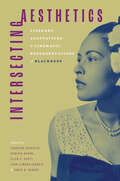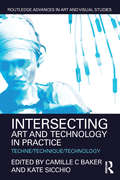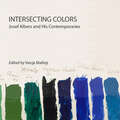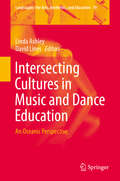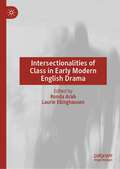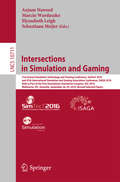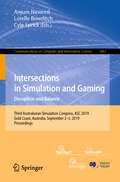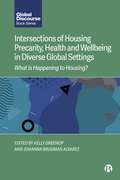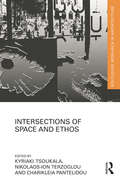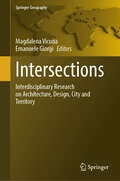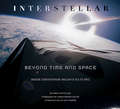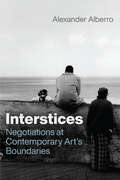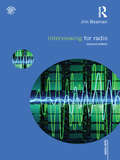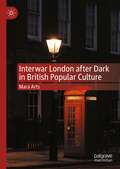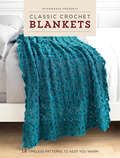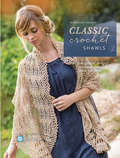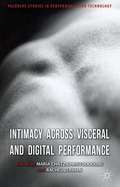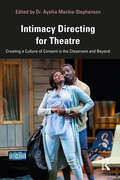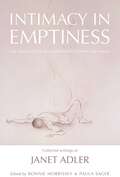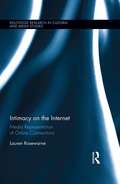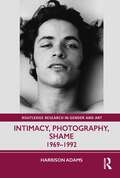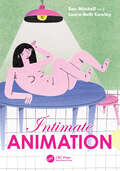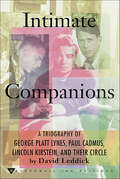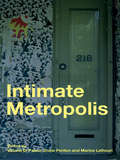- Table View
- List View
Intersecting Aesthetics: Literary Adaptations and Cinematic Representations of Blackness
by Charlene Regester, Cynthia Baron, Ellen C. Scott, Terri Simone Francis, and Robin G. VanderContributions by Cynthia Baron, Elizabeth Binggeli, Kimberly Nichele Brown, Priscilla Layne, Eric Pierson, Charlene Regester, Ellen C. Scott, Tanya L. Shields, and Judith E. Smith Intersecting Aesthetics: Literary Adaptations and Cinematic Representations of Blackness illuminates cultural and material trends that shaped Black film adaptations during the twentieth century. Contributors to this collection reveal how Black literary and filmic texts are sites of negotiation between dominant and resistant perspectives. Their work ultimately explores the effects racial perspectives have on film adaptations and how race-inflected cultural norms have influenced studio and independent film depictions. Several chapters analyze how self-censorship and industry censorship affect Black writing and the adaptations of Black stories in early to mid-twentieth-century America. Using archival material, contributors demonstrate the ways commercial obstacles have led Black writers and white-dominated studios to mask Black experiences. Other chapters document instances in which Black writers and directors navigate cultural norms and material realities to realize their visions in literary works, independent films, and studio productions. Through uncovering patterns in Black film adaptations, Intersecting Aesthetics reveals themes, aesthetic strategies, and cultural dynamics that rightfully belong to accounts of film adaptation. The volume considers travelogue and autobiography sources along with the fiction of Black authors H. G. de Lisser, Richard Wright, Ann Petry, Frank Yerby, and Walter Mosley. Contributors examine independent films The Love Wanga (1936) and The Devil’s Daughter (1939); Melvin Van Peebles's first feature, The Story of a Three Day Pass (1967); and the Senegalese film Karmen Geï (2001). They also explore studio-era films In This Our Life (1942), The Foxes of Harrow (1947), Lydia Bailey (1952), The Golden Hawk (1952), and The Saracen Blade (1954) and post-studio films The Learning Tree (1969), Shaft (1971), Lady Sings the Blues (1972), and Devil in a Blue Dress (1995).
Intersecting Art and Technology in Practice: Techne/Technique/Technology (Routledge Advances in Art and Visual Studies)
by Camille C Baker and Kate SicchioThis book focuses on the artistic process, creativity and collaboration, and personal approaches to creation and ideation, in making digital and electronic technology-based art. Less interested in the outcome itself – the artefact, artwork or performance – contributors instead highlight the emotional, intellectual, intuitive, instinctive and step-by-step creation dimensions. They aim to shine a light on digital and electronic art practice, involving coding, electronic gadgetry and technology mixed with other forms of more established media, to uncover the practice-as-research processes required, as well as the collaborative aspects of art and technology practice.
Intersecting Colors: Josef Albers and His Contemporaries
by Vanja MalloyJosef Albers (1888–1976) was an artist, teacher, and seminal thinker on the perception of color. A member of the Bauhaus who fled to the U.S. in 1933, his ideas about how the mind understands color influenced generations of students, inspired countless artists, and anticipated the findings of neuroscience in the latter half of the twentieth century. With contributions from the disciplines of art history, the intellectual and cultural significance of Gestalt psychology, and neuroscience, Intersecting Colors offers a timely reappraisal of the immense impact of Albers’s thinking, writing, teaching, and art on generations of students. It shows the formative influence on his work of non-scientific approaches to color (notably the work of Johann Wolfgang von Goethe) and the emergence of Gestalt psychology in the first decades of the twentieth century. The work also shows how much of Albers’s approach to color—dismissed in its day by a scientific approach to the study and taxonomy of color driven chiefly by industrial and commercial interests—ultimately anticipated what neuroscience now reveals about how we perceive this most fundamental element of our visual experience. Edited by Vanja Malloy, with contributions from Brenda Danilowitz, Sarah Lowengard, Karen Koehler, Jeffrey Saletnik, and Susan R. Barry.
Intersecting Cultures in Music and Dance Education
by David Lines Linda AshleyThis volume looks forward and re-examines present day education and pedagogical practices in music and dance in the diverse cultural environments found in Oceania. The book also identifies a key issue of how teachers face the prospect of taking a reflexive view of their own cultural legacy in music and dance education as they work from and alongside different cultural worldviews. This key issue, amongst other debates that arise, positions Intersecting Cultures as an innovative text that fills a gap in the current market with highly appropriate and fresh ideas from primary sources. The book offers commentaries that underpin and inform current pedagogy and bigger picture policy for the performing arts in education in Oceania, and in parallel ways in other countries.
Intersectionalities of Class in Early Modern English Drama
by Laurie Ellinghausen Ronda ArabDefining class broadly as an identity categorization based on status, wealth, family, bloodlines, and occupation, Intersectionalities of Class in Early Modern English Drama e xplores class as a complicated, contingent phenomenon modified by a wider range of social categories apart from those defining terms, including, but not limited to, race, gender, religion, and sexuality. This collection of essays – featuring a range of international contributors – explores a broad range of questions about the intersectional factors influencing class status in early modern England, including how cultural behaviors and non-class social categories affected status and social mobility, in what ways hegemonies of elite prerogatives could be disrupted or entrenched by the myriad of intersectional factors that informed social identity, and how class position informed the embodied experience and expression of affect, gender, sexuality, and race as well as relationships to place, space, land, and the natural and civic worlds.
Intersections in Simulation and Gaming: 21st Annual Simulation Technology And Training Conference, Simtect 2016, And 47th International Simulation And Gaming Association Conference, Isaga 2016, Held As Part Of The First Australasian Simulation Congress, Asc 2016, Melbourne, Vic, Australia, September 26-29, 2016, Revised Selected Papers (Lecture Notes in Computer Science #10711)
by Anjum Naweed Marcin Wardaszko Elyssebeth Leigh Sebastiaan MeijerThis book constitutes the refereed post-conference proceedings of the 21st Annual Simulation Technology and Training Conference, SimTecT 2016, and the 47th International Simulation and Gaming Association Conference, ISAGA 2016, Held as Part of the First Australasian Simulation Congress, ASC 2016, held in Melbourne, VIC, Australia, in September 2016. The 28 revised full papers included in the volume were carefully reviewed and selected from 55 submissions. They are organized in the following topical sections: Making the grade; Come to think of it; From here to fidelity; The name of the game; and Ahead of the game.
Intersections in Simulation and Gaming: Third Australasian Simulation Congress, ASC 2019, Gold Coast, Australia, September 2–5, 2019, Proceedings (Communications in Computer and Information Science #1067)
by Anjum Naweed Lorelle Bowditch Cyle SprickThis book constitutes the refereed proceedings of the Australasian Simulation Congress, ASC 2019, held in Gold Coast, Australia in September 2019. The 10 papers presented were carefully reviewed and selected from 17 submissions. They provide a forum for sharing progresses in the areas of human dimensions; gaming experience; design and application; search and rescue; defence-oriented technology and training.
Intersections of Housing Precarity, Health and Wellbeing in Diverse Global Settings: What Is Happening to Housing? (Global Discourse)
by Kelly Greenop and Johanna Brugman AlvarezThis book examines the specific manifestations and causes of housing precarity across a diverse range of geographic settings and housing types. Housing has been in crisis across the globe for decades. Precarious housing is defined as that which fails to provide an adequate standard of living to enable health and wellbeing for a person and their family. This book argues that, while causes are often structural, the forms of housing precarity need to be deeply and specifically understood in order to propose solutions. Bringing together contributions from diverse academics across different geographies in the global north and south, chapters offer fresh insights into how housing affects wellbeing in terms of physical and mental health, identity and participation in communities.
Intersections of Space and Ethos (Routledge Research in Architecture)
by Kyriaki Tsoukala Nikolaos-Ion Terzoglou Charikleia PantelidouThe pressing economic, environmental and social crises emanate the need for a redefinition of the dominant views, perspectives and values in the field of architecture. The intellectual production of the last two decades has witnessed an impressive number of new design techniques and conceptual displacements reflecting the dynamic and fluid relation between man and his dwelling space. However, the contemporary market forces are favouring the growth of a star-system in architectural production based on technological innovation, spectacular imagery and formal acrobatics, and are neglecting the social, environmental and moral implications of spatial design. Perhaps the time has come to think anew the possible critical intersections between space and ethos, not only as an answer to the negative consequences of Modernity, but also as a remedy to the negative aspects of globalisation. The aim of the present collective volume is to enliven the ethical dimensions and dilemmas of architecture as they are shaped within the complexity of our times on two levels: the level of critical and reflective discourse and the level of social and cultural reality occasioned by post-industrial modes of production and new technologies. Thirteen distinguished academics and researchers investigate the complex relations between architecture, space and ethics from divergent and inter-disciplinary perspectives: philosophy, sociology, the humanities, the arts, landscape design, environmental design, urban design and architectural history and theory.
Intersections: Interdisciplinary Research on Architecture, Design, City and Territory (Springer Geography)
by Emanuele Giorgi Magdalena VicuñaThis book presents a critical vision of the role of architecture and design in constantly changing cities, territories and societies from a Latin American perspective. Topics include, pandemic and post-pandemic; public culture and aesthetics; right to housing, city and services, gender approach and ethics of care; heritage and cultures, critical methodology; sustainable landscapes; perceptions and emotions; processes and technologies; territories and intermediate cities. The IV Intersections Congress was organized by high-level universities in Latin American: faculties of architecture, design and urban studies that came together during an historical moment of great changes. The congress was an invitation to weave conversations that address the tensions emerging in local, regional and global debates, with the goal of understanding how architecture, design, city and territory are a relevant intersection for these tensions. This translation was done with the help of artificial intelligence. A subsequent human revision was done primarily in terms of content.
Interstellar: Beyond Time And Space
by Mark Cotta VazIn his sci-fi epic Interstellar, Christopher Nolan takes on the infinite canvas of space to deliver a cutting-edge, emotionally charged adventure that will amaze audiences of all ages. <P><P> Interstellar: Beyond Time and Space documents the making of Nolan's latest masterpiece in fascinating detail and features interviews with the acclaimed director, along with screenwriter Jonathan Nolan, producer Emma Thomas, and other key members of the production team. Delving into the science and philosophy behind the film, Interstellar: Beyond Time and Space dynamically showcases its incredible concept art, including costume designs, storyboards, and other fascinating preproduction elements. Also featuring interviews with the exceptional cast, including Matthew McConaughey and Anne Hathaway, Interstellar: Beyond Time and Space tells the full story of the making of the film, with candid pictures illustrating its elaborate set pieces and reliance on classic special effects techniques. Visually enthralling and engrossing in its in-depth exploration of the themes and ideas at the heard of Interstellar, this book is the perfect accompaniment to one of the most anticipated films of 2014. Based on the film from Warner Bros. Pictures and Paramount Pictures. From acclaimed filmmaker Christopher Nolan ("The Dark Knight" films, "Inception"), "Interstellar" stars Oscar winner Matthew McConaughey ("Dallas Buyers Club"), Oscar winner Anne Hathaway ("Les Miserables"), Oscar nominee Jessica Chastain ("Zero Dark Thirty"), Bill Irwin ("Rachel Getting Married"), Oscar winner Ellen Burstyn ("Alice Doesn't Live Here Anymore"), and Oscar winner Michael Caine ("The Cider House Rules"). The main cast also includes Wes Bentley, Casey Affleck, David Gyasi, Mackenzie Foy and Topher Grace. Christopher Nolan directed the film from a screenplay he co-wrote with Jonathan Nolan. Emma Thomas, Christopher Nolan and Lynda Obst produced "Interstellar," with Jordan Goldberg, Jake Myers, Kip Thorne and Thomas Tull serving as executive producers. Warner Bros. Pictures and Paramount Pictures present, in association with Legendary Pictures, a Syncopy/Lynda Obst Productions production, a film by Christopher Nolan, "Interstellar. " INTERSTELLAR and all related characters and elements are trademarks of and © Warner Bros. Entertainment Inc. (s14)
Interstices: Negotiations at Contemporary Art’s Boundaries (Abakanowicz Arts and Culture Collection)
by Alexander AlberroAn exploration of innovative practices flourishing at the margins of Western art. With this book, Alexander Alberro engages decolonial theory to explore the dynamic exchanges that occur where the ideals and values of different artistic frameworks meet. Resisting notions of a singular art world and global contemporary art, Alberro explores what lies outside of Western art’s hegemonic presence, recognizing the rich multitude of art formations at its periphery, each with its own artistic narratives and conventions. Alberro brings into focus the complex negotiations that are cultivating innovation and transformation at the margins of Western art, showing how this seemingly monolithic framework is both crucial to and insufficient for a comprehensive understanding of contemporary art. His examples include artists and collectives from around the world, including Iosu Aramburu, Subhankar Banerjee, Yto Barrada, Mabe Bethônico, El Colectivo, Maria Galindo and Mujeres Creando, Bouchra Khalili, Multiplicity, Lucy Orta, Raqs Media Collective, Tracey Rose, Doris Salcedo, Yinka Shonibare, World of Matter, and Yin Xiuzhen. As notions of transculturation and decoloniality continue to drive conversations about contemporary art, Interstices offers a critical explanation of what is at stake, showing how the tensions at the edges of the Western art framework are pushing it toward its discursive limits.
Interviewing for Radio (Media Skills)
by Jim Beaman'Jim Beaman’s Interviewing for Radio is a classic and seminal practice text, brilliantly written and masterful in its content. Nobody working in professional radio can do without it. It is a must for all radio courses and I could not recommend it more highly' - Tim Crook, Head of Radio, Goldsmiths College, University of London, UK Interviewing for Radio is a thorough introduction to the techniques and skills of the radio interview. It offers advice on how to ask the right question and elicit a response, and guides the reader through the use of equipment, the mechanics of recording, the studio environment, live broadcasts, presentation and pronunciation, and editing material. Written by an experienced producer and instructor, Interviewing for Radio includes: the history of the radio interview and the importance of its role today practical exercises which introduce successful interview and technical skills case studies and hypothetical scenarios to help you prepare for potential difficulties a discussion of ethics, risk assessment, codes of conduct and regulations This second edition has been thoroughly updated and includes advice from a new range of practitioners, and examples of recent UK and international interviews. The author critically analyses these interviews and explains the preparation, organisation and expertise required in order to produce a successful radio broadcast. Interviewing for Radio references both new and existing regulations and guidelines for UK journalists, then offers a global perspective by drawing on the differences and similarities with those applicable to other countries. This invaluable book is supported by a companion website that includes audio interviews with practitioners accompanied by a range of student exercises, a comprehensive glossary in the form of interactive flashcards, and suggested links for further listening.
Interwar London after Dark in British Popular Culture
by Mara ArtsThis book explores the representation of London’s nightlife in popular films and newspapers of the interwar period. Through a series of case-studies, it analyses how British popular media in the 1920s and 1930s displayed the capital after dark. It argues that newspapers and films were part of a common culture, which capitalized on the transgressive possibilities of the night. At the same time both media ensured that those in authority, such as the police, were always shown to ultimately be in control of the night. The first chapter of the book provides an overview of the British film and newspaper industries in the interwar period. Subsequent chapters each explore a specific aspect of London’s nightlife. In turn, these chapters consider how films and newspapers of the interwar period depicted women navigating the street at night; the Metropolitan Police’s involvement in nightlife; and the capital’s newly built and expanded suburbs and public transport network. Finally, the book considers how newspapers and films depicted themselves and one another.
Interweave Favorites - 25 Knitted Accessories to Wear and Share
by InterweaveA handpicked selection of 25 favorite patterns from Interweave. The first in a new series, Interweave Favorites: 25 Knitted Accessories to Wear and Share is a collection of cozy patterns carefully curated from our roster of incredible authors and designers and brought together in a single book. Knitters of all levels will find plenty of standout projects to make and love, from warm socks to delicate shawls; from colorful mitts to scarf and hat sets. Most projects can be knitted speedily enough to become timely gifts, while a few--such as an Estonian lace shawl--require more time (but are worth it). Featuring classic styles with some modern twists, Interweave Favorites: 25 Knitted Accessories to Wear and Share truly offers something for everyone.
Interweave Presents Classic Crochet Blankets: 18 Timeless Patterns to Keep You Warm
by Interweave EditorsWarm Your Home with Crocheted CozinessPractical, timeless, and easy to make, crocheted blankets can turn any house in to a home. Interweave Presents Classic Crochet Blankets shares 18 projects for crochet afghans, blankets, and throws you'll love to make and use.The clever and classic designs featured in this collection explore a variety of techniques and crochet stitches, including lovely lacework, textured cables, creative colorwork, and stash-busting granny squares. The projects are worked in several different ways: from the center out, in rows, and in crochet motifs that are joined. A helpful tutorial on crochet symbols and a mini-library of crochet edgings you can use to further customize your afghans round out this wonderful resource.Cozy up to Interweave Presents Classic Crochet Blankets!
Interweave Presents Classic Crochet Shawls: 20 Free-Spirited Designs Featuring Lace, Color and More
by Interweave EditorsComplete Your Look with Crochet! Whether your laid-back style is vintage, modern, or somewhere in between, a crocheted shawl is nothing less than a wardrobe essential. It can turn up the personality of any outfit--especially if it's hand stitched by you! For this stunning collection, we dug into the Interweave archive and carefully selected 20 of our most-loved crochet shawls. Not just for spring, these shawls vary in weight and warmth, from light and lacy for a warm summer evening to cozy and textured to protect against winter's chill. So you can keep your hook busy year-round--and explore new techniques while you're at it. Try your hand at intricate lace work with the Eolande Shawlette. Explore a new motif with the Pleiades Shawl. Or add some beads to your stitching with the Emergence Shawl. Whichever shawl you crochet, it's sure to make a statement when you step out in boho style.
Intimacy Across Visceral and Digital Performance
by Maria Chatzichristodoulou Rachel ZerihanConsisting of critical analyses, theoretical provocations and practical reflections by leading scholars/practitioners from the fields of performance studies, live art and creative technology, these essays examine the rise of intimate performance works and question the socio-historical contexts provoking those aesthetic and affective developments.
Intimacy Directing for Theatre: Creating a Culture of Consent in the Classroom and Beyond
by Dr Ayshia Mackie-StephensonIntimacy Directing for Theatre provides much needed strategies on how teachers and artists can do intimacy work in the classroom and rehearsal room that is safe and just. This book puts forth intimacy work that is based on human rights and consent for everyone, fully integrating justice with intimacy directing. It offers practical advice on how instructors can do intimacy work in their courses and productions that is based on consent and racial and gender justice. Each chapter is written by an instructor and professional practitioner who offers their perspective and experience on how to cultivate a space that is safe and intersectional, as well as respectful of students’ race, gender, sexual orientation, and other integral modes of identity. Chapters contain "low stakes" exercises that help to keep the rehearsal room safe, consensual, and inclusive. Intimacy Directing for Theatre is an excellent resource for Theatre & Performance instructors and practitioners who want to create and sustain a culture of consent in their classrooms and rehearsal rooms.
Intimacy in Emptiness: An Evolution of Embodied Consciousness
by Janet Adler• Offers insights from the author&’s 50-year study of the inner witness developing toward compassionate presence, intuitive knowing, and direct experience of the divine• Illuminates how commitment to this mystical practice supports participation in evolving consciousness within groups, grounded in personal healingThe Discipline of Authentic Movement, grounded in the relationship between a mover and a witness, connects us directly with the inner wisdom of the body. In the emptiness of the movement space, a mover&’s inner experience--feelings, sensations, images, and thoughts--become outer, unchoreographed gestures. Seen by their inner witness in the presence of an outer witness, the mover steps into the intimate mystery of who they are becoming. Sharing vivid examples from founder of the Discipline of Authentic Movement Janet Adler&’s 50-year inquiry, Intimacy in Emptiness brings her essential writings, including new and previously unpublished work, to a wider audience, guiding readers through the multiple layers of this experiential and innovative approach to embodied consciousness. Her writings illuminate the path of the developing inner witness, transforming toward compassionate presence, conscious speech, and intuitive knowing. This contemporary mystical practice, a breakthrough in the field of consciousness studies, includes personal healing as an essential base from which direct experience of the numinous can safely emerge, be witnessed, and become integrated into the fullness of the whole person. The emergence of the unique gesture and voice of each individual develops toward participation in consciously embodied groups. A new form of intelligence moves through collective bodies in service of healing in our world.
Intimacy on the Internet: Media Representations of Online Connections (Routledge Research in Cultural and Media Studies)
by Lauren RosewarneThe focus of this book is on the media representations of the use of the Internet in seeking intimate connections—be it a committed relationship, a hook-up, or a community in which to dabble in fringe sexual practices. Popular culture (film, narrative television, the news media, and advertising) present two very distinct pictures of the use of the Internet as related to intimacy. From news reports about victims of online dating, to the presentation of the desperate and dateless, the perverts and the deviants, a distinct frame for the intimacy/Internet connection is negativity. In some examples however, a changing picture is emerging. The ubiquitousness of Internet use today has meant a slow increase in comparatively more positive representations of successful online romances in the news, resulting in more positive-spin advertising and a more even-handed presence of such liaisons in narrative television and film. Both the positive and the negative media representations are categorised and analysed in this book to explore what they reveal about the intersection of gender, sexuality, technology and the changing mores regarding intimacy.
Intimacy, Photography, Shame: 1969–1992 (Routledge Research in Gender and Art)
by Harrison AdamsThis study argues that intimacy requires an overcoming of shame, and each of these artists, in their own way, uses photography to frame moments that can be shameful to some and intimate others, leaving it to the viewer to navigate this affectively perilous terrain.From the cancellation of Mapplethorpe’s retrospective The Perfect Moment to the obscenity trial in Cincinnati shortly thereafter, to Hujar’s lesser-known but equally “hardcore” imagery, to Goldin’s gritty depictions of domestic violence and substance abuse, to the accusations of child pornography thrown at Mann’s photographs of her own children, the photographers at the heart of this book have probed the limits of acceptability. But there is more to their work than merely controversy; it’s what causes the controversy that matters. The notion of intimacy is at stake in some of our most important human relationships, and thus a great deal hinges on both achieving and preserving intimacy.This book will be of interest to scholars working in art history, photography and gender studies.
Intimate Animation
by Ben Mitchell Laura-Beth CowleyIn recent years, there has been a surge in animated projects that have pushed boundaries, broken taboos, prompted discussions and wowed festival and online audiences alike through compelling storytelling and unmatched artistry.Join Ben Mitchell and Laura-Beth Cowley of Skwigly Online Animation Magazine and the Intimate Animation podcast as they take you on a tour of the landscape of contemporary animated films that deal with themes of love, intimacy, relationships, anatomy and sexuality – and the incredible artists behind them. Through research and firsthand interviews with trailblazers such as Signe Baumane, Andreas Hykade, Ruth Lingford, Michaela Pavlatova, Bill Plympton and Joanna Quinn, as well as newer voices including Sawako Kabuki, Renata Gąsiorowska, Will Anderson, Sara Gunnarsdottir, Michaela Mihalyi, David Stumpf, Levi Stoops, Lori Malepart-Traversy, Anna Ginsburg, Veljko Popović, Renee Zhan and more, Intimate Animation looks deeply at the role animation has played in presenting elaborate and complex concepts relating to love and sexuality.Exploring the role animation has played in sex education, self-discovery, the body, lust and love, as well as how the medium can be used to visually represent emotions, feelings and concepts not easily described in words nor depicted through live-action filmmaking, Intimate Animation is the ideal book for professional animators, filmmakers, enthusiasts, researchers, academic and students of animation and film studies interested in the themes of love and sexuality.
Intimate Companions: A Triography of George Platt Lynes, Paul Cadmus, Lincoln Kirstein, and Their Circle
by David LeddickPhotographer George Platt Lynes, painter Paul Cadmus, and critic Lincoln Kirstein played a major role in creating the institutions of the American art world from the late 1920s to the early 1950s. The three created a remarkable world of gay aesthetics and desire in art with the help of their overlapping circle of friends, lovers, and collaborators.Through hours of conversation with surviving members with their circle and unprecedented access to papers, journals, and previously unreleased photos, David Leddick has resurrected the influences of this now-vanished art world along with the lives and loves of all three artists in this groundbreaking biography.
Intimate Metropolis: Urban Subjects in the Modern City
by Vittoria Di Palma Diana Periton Marina LathouriIntimate Metropolis explores connections between the modern city, its architecture, and its citizens, by questioning traditional conceptualizations of public and private. Rather than focusing purely on public spaces—such as streets, cafés, gardens, or department stores—or on the domestic sphere, the book investigates those spaces and practices that engage both the urban and the domestic, the public and the private. The legal, political and administrative frameworks of urban life are seen as constituting private individuals’ sense of self, in a wide range of European and world cities from Amsterdam and Barcelona to London and Chicago. Providing authoritative new perspectives on individual citizenship as it relates to both public and private space, in-depth case studies of major European, American and other world cities and written by an international set of contributors, this volume is key reading for all students of architecture.
